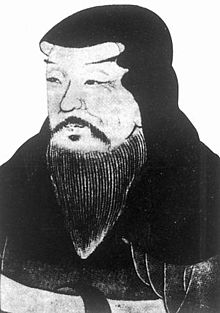Xu Shen
Xu Shen ( Chinese 許慎 / 许慎 , Pinyin Xǔ Shèn , majority name 叔 重 , Shūzhòng ; * in the 1st century , † after 120 ) was a Chinese scholar who lived during the Han Dynasty . He wrote the Shuowen Jiezi ( 說文解字 / 说文解字 ), the first dictionary of the Chinese language and script .
Life
Xu Shen came from the city of Luohe in the province of Henan . He served as an officer in Runan . He later moved to the provincial administration, where he last worked as an official in Pei County . After retiring, he lived as a private scholar and likely died over the age of 90.
According to the judgment of the scholar Ma Rong, Xu Shen was an excellent expert on Chinese writing and literature, especially the Confucian classics . He wrote a commentary on the Five Classics of Confucianism under the title Wujing Yiyi ( 五 經 異 義 / 五 经 异 义 , Wǔjīng Yìyì - "Different interpretations of the Five Classics"), the fragments of which offer valuable insights into the understanding of the classics in the 2nd century.
His best-known work is the Shuowen Jiezi , the first systematic lexicon of Chinese. It lists 9,353 characters with over 1,000 variants. Xu Shen was the first to use the radical order of signs . He traced the Chinese characters back to 540 radicals. This number was later reduced until it was fixed at 214 by the Kāngxī Zìdiǎn in 1716 .
Xu Shen saw his lexicon as a contribution to understanding the Confucian classics. Although he had already completed it around 100, the work was only presented to the imperial court in 121 (under Kaiser An ). Since Xu Shen was already old and could no longer travel, his son Xu Chong presented the dictionary to the court.
In the district of Yancheng of Luohe there is Xu Shen Museum ( 漯河郾城區許慎紀念館 / 漯河郾城区许慎纪念馆 , Luohe Yǎnchéng Qū Xǔ Shen Jìniànguǎn ).
literature
- Rafe de Crespigny : A Biographical Dictionary of Later Han to the Three Kingdoms (23-220 AD). Suffering u. a .: Brill 2007, p. 910 ( Handbook of oriental studies . Section 4, Volume 19) ISBN 978-90-04-15605-0
| personal data | |
|---|---|
| SURNAME | Xu Shen |
| ALTERNATIVE NAMES | Xu Shuzhong |
| BRIEF DESCRIPTION | Author of Shuowen Jiezi, the first dictionary in Chinese script |
| DATE OF BIRTH | 1st century |
| DATE OF DEATH | after 120 |
